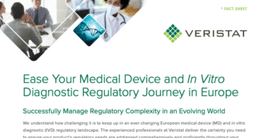The Influence of MDR’s Article 117 in the Marketing of Combination Products
ART PODCAST | SEASON 3 | EPISODE 9
In this episode of Advancing Revolutionary Therapies, Andrea Larrañaga, Associate Manager, Regulatory Affairs at Veristat, speaks to Laura Ocaña and Gemma Dorrego, both of whom are Associate Regulatory Affairs Strategists also at Veristat, about the influence of the Medical Device Regulation’s (MDR) Article 117 on the marketing of Combination products.
Check out the full episode to learn or read the summary below.
What is Article 117 of the MDR?
Andrea: Article 117 of the MDR amends the Directive 2001/83/EC and requests the involvement of a notified body for one kind of Combination product (single integral products) to assess the conformity of the device part with the relevant general safety and performance requirements (GSPR). Before talking in depth about Article 117, we first need to talk about combination products. How is a combination product defined?
Gemma Dorrego: Combination products are defined as products that combine a medicinal product and a medical device and are regulated either by the Medical Device Regulation (MDR) or the Medicinal Product Directive, depending on their principal mode of action. There are two main groups of drug device combination (DDC) products: integral DDCs and non-integral DDCs.
Andrea: What are integral DDCs and non-integral DDCs?
Gemma Dorrego:
Non-integral DDCs are products in which the medical device (MD) and the medicinal product are regulated independently. Depending on how these products are marketed, the regulatory requirements can vary (i.e., co-packaged products).
Integral products are medicinal products and medical devices combined as one entity. Both are needed for the correct performance of the device. There are two kinds of integral products:
-
If the main mode of action is done by the medical device, the action of the medicinal product must be considered as “ancillary” to that of the device, and the product shall be assessed and authorized in accordance with the MDR. One example of this is drug-eluting stents where the main action is done by the stent and the eluting agents help with the proper use of the medical device.
-
If the main mode of action of the product is done by the medicinal product, the products should be authorized under the scope of the medicinal product legislation. An example of this would be a pre-filled syringe.
Andrea: When does Article 117 apply specifically?
Laura Ocaña: Article 117 applies to single integral products in which the main mode of action is done by the medicinal product. One example would be a non-reusable MD used to administer a medicinal product like a single-use pre-filled syringe. Another example would be an MD that incorporates as an integral part a medicinal product like a scaffold with an oncological medicinal product implanted in the body to treat a tumor.
Andrea: Before the amendment of this article, what was the scenario? What do you think about the approach that the European Commission (EC) took?
Laura Ocaña: The article was necessary because drugs and MDs were regulated independently, and the combination was not considered or regulated as a whole product. The medicinal product regulation did not specify the exact procedure to ensure the safety of the integral combination products. This amendment to the medicinal product’s directive will promote the exchange of information between the EMA, medical device manufacturers, and notified bodies to ensure the safety of the product once it is marketed.
Gemma Dorrego: This is also necessary due to the increase in the number of medicinal products that are developed for use with medical devices. The amendment of the article will increase the safety of these kinds of products, but it will also increase the obligations of the manufacturers.
The Impact of Article 117 on Manufacturers
Andrea: What are the implications that this article has? What new requirements will the manufacturer have to fulfill with Integral DDC products in which the primary actions are done by the drug?
Laura Ocaña: There are two possible scenarios. The medical device can be CE marked or not CE marked. For example, if a pre-filled syringe has the CE mark, the manufacturer will only have to add the certificate to their Marketing Authorization Application (MAA). However, if a product is not CE marked, such as the scaffold previously mentioned that could have been developed specifically for that medicinal product, a Notified Body Opinion (NBOp) is triggered.
Andrea: What is a Notified Body Opinion (NBOp)?
Gemma Dorrego: NBOp is an assessment of the conformity of the device part with the relevant GSPR as set out in Annex I of MDR, which ensures the safety of the device when used with the medicinal product. The Notified Body (NB) will assess the suitability of the device for its intended purpose before putting it on the market; the NBOp will have to be included in the Marketing Authorization Application; and the company responsible for obtaining the MAA will be in charge of obtaining the NBOp.
Andrea: Although the documentation that needs to be provided for an NBOp is not a full Technical Documentation, will most of the aspects have to be covered?
Laura Ocaña: Yes. The NBOp will not be based on a full assessment of the technical documentation of the device. Documents regarding the safety, performance, and compatibility between the device part and the medicinal product will be assessed from different documents provided by the manufacturer: the test reports, including stability studies, risk management reports, clinical evaluation, and biological evaluations, among other information needed to provide objective evidence on the conformity of the medical device part with the applicable GSPR.
Andrea: How do timelines affect the manufacturer’s development schedule?
Gemma Dorrego: The total duration once the NBOp dossier is submitted varies between 2-6 months depending on the clock stops and the documentation status when provided.
Andrea: This is extra work for the manufacturer and could be challenging, that’s why we recommend all manufacturers first analyze if they will need an NBOp and, if that’s the case, to plan accordingly to avoid delays. To summarize, what are the main pros and cons of this legislative change?
Gemma Dorrego: One of the main advantages of Article 117 is the improved safety of the integral DDC that is being marketed since the safety, performance, and compatibility of the medical device and the medicinal product are strictly reviewed. However, this also means that a lot more time, extra work, and more resources are needed by the manufacturer, especially considering that, if needed, an NBOp can push the timeline.
Laura Ocaña: Since a more organized procedure is now established, it will be easier for manufacturers to know how to proceed in these cases. In contrast, this is a new procedure for Notified Bodies (NB) and the EMA, so there will be uncertainty regarding the timings of the procedure, which may affect the time needed to put these types of products on the market. This will improve as the number of procedures increases, and all the pieces needed to obtain the NBOp are well engaged. All the procedures requiring the participation of an NB must also be planned in advance because NBs are overloaded. The NB must be contacted as soon as possible when it is expected to be involved in any procedure.











